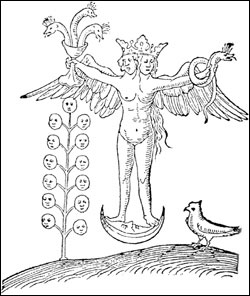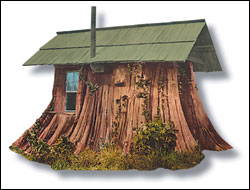The word “alchemy” once described the ancient process that allegedly turned lead into gold. Nowadays, it’s used metaphorically to explain the success of everything from Russell Crowe’s film career to how Enron execs got rich. But old-school alchemy is hardly forgotten. In fact, in book publishing it’s undergoing a mini-Renaissance. There are probably more books on alchemy being published today than at any time since the 17th century.
Part of the appealalong with the New Age faddishness of astrology, Kabbalah, and chatting with angelsis the post- Joseph Campbell popularization of myth. Alchemy’s visual legacy is stunning, a symbolic language that fascinated psychologist Carl Jung. Its vocabulary includes flying dragons, green lions, and floating hermaphroditesall representing, according to Jung, aspects of our own psychic processes. Perhaps the most potent symbol that endures, however, is the alchemist himself: the lone wizard or mage who uses magic to overcome adversity (see Harry Potter and Lord of the Rings).
Alchemy has also proved to be an academic gold mine of sorts. Once scorned, alchemists and their musings (broadly called “Hermetic philosophy”) have gained new respect as revisionist scholars have uncovered the fact that they indeed had a profound impact on the history of science, philosophy, and the arts. What was once dismissed as scientific quackery or occult woo-woo has been shown to have been a major influence on Newton, Hegel, and Goethe, among others.
For anyone on your list who is interested in esoterica, philosophy, or the sources that have inspired writers like J.K. Rowling and J.R.R. Tolkien, alchemical books offer a rich vein of lore.
A great visual sampler is The Hermetic Museum: Alchemy and Mysticism by Alexander Roob (Taschen, $30). This fat, 700-page handbook-size compendium captures the incredibly rich artistic tradition of alchemy, from medieval woodcuts to the illustrations of William Blake. Alchemists were secretive, sharing their techniques only with the spiritually pure and initiated. Thus, their imagery is a kind of surrealistic code loaded with hidden meaning. Some find the images a kind of mandala: sources of spiritual inspiration.
Alchemical texts are much harder to relate to. They were purposely obscure, reading like allegorical lab notes for long forgotten procedures. However the broader philosophical works that outline the alchemical worldview include tracts by Plato, Aristotle, Roger Bacon, Paracelsus, the legendary sage Hermes Trismegistus, and even Sir Isaac Newton himself. They lay out the assumptions behind “the Art,” in essence, the structure of a universe that could explain the mysterious transmutation of substances from the imperfect to the perfect. The unofficial Hermetic motto was “As above, so below,” which was taken to mean that God’s perfection could be replicated on Earth if the pure-hearted could decipher his methods. Newton attempted to forge a kind of unified theory of reality that was equal parts science, alchemy, and religion. Washington State University professor emeritus Stanton J. Linden, whose expertise includes alchemical imagery in English literature starting with Chaucer, has gathered a selection of key alchemical works into The Alchemy Reader (Cambridge University Press, $25), a new and valuable source of how these complicated ideas were originally expressed.
Another example of a Hermetic text has local ties. Seattle bookseller William Kiesel has published (in a small edition of 1,000) Picatrix: The Goal of the Wise (Ouroboros Press, $50). Called Ghayat Al-Hakim in Arabic, it is a new English translation of an 11th-century manuscript on talismanic magic and astrology that was a very influential source work for the Hermetic philosophers of the Renaissance. The book is intended to be the first of a series bringing some of these hard-to-find works back into print.
A number of recent books have helped to “out” various figures as closet alchemists, among them Aspiring Adept: Robert Boyle and his Alchemical Quest by Lawrence Pincipe (Princeton University Press, $23.95); Hegel and the Hermetic Tradition by Glenn Alexander Magee (Cornell University Press, $42.95); and The Janus Face of Genius: The Role of Alchemy in Newton’s Thought by Betty Jo Teeter Dobbs (Cambridge University Press, $33). These are all scholarly works that ask you to rethink your assumptions about these great men and their motivations.
Even more interesting is finding out about historical figures who ought to be better known in the first place. One of these is American George Starkey, a Harvard-educated 17th-century scientist who emigrated in reverse (to Britain) and became an enormously influential alchemist. His story is told in the Gehennical Fire: The Lives of George Starkey, American Alchemist in the Scientific Revolution (University of Chicago Press, $27.50).
Lastly, of course, something for the kids. There’s Sophia, the Alchemist’s Dog by Shelley Jackson (Simon & Schuster, $17.95), an illustrated children’s storybook told from the dog’s point of view. Sophia’s master is the king’s alchemist, and he’s fighting a serious deadline: produce a lump of gold or else. Unfortunately, no can do. Will the plucky Sophia save the day? Does she need to? The author/illustrator has clearly studied alchemical imagery and terminology and knows enough to send the message that perhaps the most powerful legacy of this lost art is the alchemy of the creative process.







